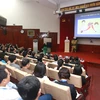Vietnam has faced a heavy disease burden with both communicable and non-communicable diseases, stated Deputy Health Minister Nguyen Thi Xuyen.
Despite general control of infectious diseases, they remain a threat to the health of the country coupled with up to 73 percent of mortality as a result of non-infectious diseases, mostly heart disease and cancer, she said at a seminar on the interaction of contagious, non-contagious and environmental diseases in Hanoi on March 24.
Vietnam has also countered various environmental risks, including unsafe food and air pollution, said Xuyen.
She said she hopes seminar participants will suggest priority plans for researching, disrupting and preventing diseases in Vietnam.
Reports at the event revealed that like many other low-income countries, Vietnam is facing both high-risk infectious and increasing rates of non-infectious diseases. Rapid urbanisation and environmental pressure are contributing factors of epidemic transformation.
Stroke, coronary disease, liver cancer and lung disease are four of the leading causes of death in Vietnam, killing 150,000 people each year, according to a disease burden report.
Air pollution is a major contributor to the heavy disease burden, said the report, adding that dengue fever is expanding with over 70,000 cases each year. Bird flu virus H5N1, foot-and-mouth disease and measles are also among threats to the community.
The two-day seminar will also focus on clarifying infectious challenges in Vietnam, impacts of environmental pollution to communicable and non-communicable diseases, and the role of the private sector in dealing with the double disease burden.-VNA
Despite general control of infectious diseases, they remain a threat to the health of the country coupled with up to 73 percent of mortality as a result of non-infectious diseases, mostly heart disease and cancer, she said at a seminar on the interaction of contagious, non-contagious and environmental diseases in Hanoi on March 24.
Vietnam has also countered various environmental risks, including unsafe food and air pollution, said Xuyen.
She said she hopes seminar participants will suggest priority plans for researching, disrupting and preventing diseases in Vietnam.
Reports at the event revealed that like many other low-income countries, Vietnam is facing both high-risk infectious and increasing rates of non-infectious diseases. Rapid urbanisation and environmental pressure are contributing factors of epidemic transformation.
Stroke, coronary disease, liver cancer and lung disease are four of the leading causes of death in Vietnam, killing 150,000 people each year, according to a disease burden report.
Air pollution is a major contributor to the heavy disease burden, said the report, adding that dengue fever is expanding with over 70,000 cases each year. Bird flu virus H5N1, foot-and-mouth disease and measles are also among threats to the community.
The two-day seminar will also focus on clarifying infectious challenges in Vietnam, impacts of environmental pollution to communicable and non-communicable diseases, and the role of the private sector in dealing with the double disease burden.-VNA



















